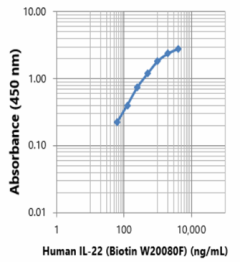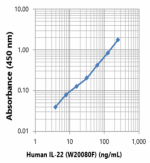- Clone
- W20080F (See other available formats)
- Regulatory Status
- RUO
- Other Names
- IL22, IL-D110, IL-TIF, MGC79382, TIFIL-23, TIFa, zcyto18
- Isotype
- Mouse IgG2b, κ
- Ave. Rating
- Submit a Review
- Product Citations
- publications

-

Direct ELISA showing biotin anti-human IL-22 (clone W20080F) bound to plate-immobilized recombinant human IL-22 protein (Cat. Nos. 571302, 571304, 571306, and 571308). The wells were incubated with serially diluted biotin primary antibody at room temperature for 2 hours in 1% BSA-PBS, followed by incubation with HRP Avidin (Cat. No. 405103). TMB substrate (Cat. No. 421501) was used for detection. Absorbance was measured at 450 nm.
| Cat # | Size | Price | Quantity Check Availability | Save | ||
|---|---|---|---|---|---|---|
| 618053 | 50 µg | £182 | ||||
IL-22 is a cytokine structurally related to IL-10. It was originally identified in mouse as a gene induced by IL-9 in T cells and mast cells. IL-22 was initially designated as ILTIF (IL-10-related T cell-derived inducible factor). IL-22 belongs to a family of cytokines with limited homology to IL-10, namely IL-10, IL-19, IL20, IL-24, IL-26, IL-28A, IL-28B and IL-29 (the later three also known as IFN-λ). Human IL-22 shares 79% amino acid identity with mouse IL-22 and 25% identity with human IL-10. IL-22 biological activity is initiated by the binding to a cell surface complex composed of IL-22R1 and IL-10R2 receptor chains and further regulated by interactions with a soluble binding protein, IL-22BP, which share sequence similarity with an extracellular region of IL-22R1 (sIL-22R1). Both chains of the IL-22R complex belong to the class II CRF. Two types of IL-22 binding receptors have been discovered, a membrane-bound receptor and a soluble receptor, both encoded by different genes. IL-22 is produced by immune cells and acts on nonimmune cells to regulate local tissue inflammation. As a product of T helper 17 lineage of CD4 (+) effector lymphocytes, IL-22 plays a critical role in mucosal immunity as well as in deregulated inflammation observed in autoimmune diseases.
Product DetailsProduct Details
- Verified Reactivity
- Human
- Antibody Type
- Monoclonal
- Host Species
- Mouse
- Immunogen
- Human Recombinant IL-22 Protein
- Formulation
- Phosphate-buffered solution, pH 7.2, containing 0.09% sodium azide
- Preparation
- The antibody was purified by affinity chromatography and conjugated with biotin under optimal conditions.
- Concentration
- 0.5 mg/mL
- Storage & Handling
- The antibody solution should be stored undiluted between 2°C and 8°C. Do not freeze.
- Application
-
Direct ELISA - Quality tested
- Recommended Usage
-
Each lot of this antibody is quality control tested by Direct ELISA. The optimal concentration of this reagent for the specific application and the experiment design should be established by the end-user.
- Additional Product Notes
-
This product is intended for sandwich-based immunoassay development on various assay platforms requiring antibody pairs. This antibody (clone W20080F) could function as a detection antibody when paired with purified anti-human IL-22 antibody (Cat. No. 617852) (clone A20056F) as the capture antibody and using Recombinant Human IL-22 protein (Cat Nos. 571302, 571304, 571306, and 571308) as the assay standard.
- RRID
-
AB_3083221 (BioLegend Cat. No. 618053)
Antigen Details
- Structure
- Cytokine
- Distribution
-
Thymic lymphomas, T cells, activated T cells, macrophages, and mast cells
- Function
- Enhances the production of acute phase proteins in a hepatocyte cell line, HepG2; promotes Th17 cells to transmigrate through the blood-brain barrier in multiple sclerosis
- Interaction
- Interacts with a cell surface complex composed of IL-22R1 and IL-10R2 receptor chains which are expressed in epithelial cells of inflammatory diseases such as psoriasis, Crohn's disease, rheumatoid arthritis, or allergic asthma
- Ligand/Receptor
- IL-22R1 and IL-10R2 receptor chains
- Biology Area
- Cell Biology, Immunology, Stem Cells
- Molecular Family
- Cytokines/Chemokines
- Antigen References
-
- Nagalakshmi ML, et al. 2004. Intern Immunopharmacol 4:679-91.
- Kebir H, et al. 2007. Nat Med. 13:1173-5.
- Gu Y, et al. 2008. Eur J Immunol. 38:1807-13.
- Pene J, et al. 2008. J Immunol. 180:7423-30.
- Dumotier L, et al. 2000. J immune. 164:1814-1819.
- Xie MH, et al. 2000. J Biol Chem. 765:31335-9.
- Jones BC, et al. 2008. Structure. 1333-44.
- Kotenko SV, et al. J Immunol. 166:7096-103.
- Chang C, et al. 2006. Cell Res 16:902-7.
- Gene ID
- 50616 View all products for this Gene ID
- UniProt
- View information about IL-22 on UniProt.org
Related FAQs
- How many biotin molecules are per antibody structure?
- We don't routinely measure the number of biotins with our antibody products but the number of biotin molecules range from 3-6 molecules per antibody.
Other Formats
View All IL-22 Reagents Request Custom Conjugation| Description | Clone | Applications |
|---|---|---|
| Purified anti-human IL-22 | W20080F | Direct ELISA |
| Biotin anti-human IL-22 | W20080F | Direct ELISA |
Compare Data Across All Formats
This data display is provided for general comparisons between formats.
Your actual data may vary due to variations in samples, target cells, instruments and their settings, staining conditions, and other factors.
If you need assistance with selecting the best format contact our expert technical support team.
-
Purified anti-human IL-22

Direct ELISA showing purified anti-human IL-22 (clone W20080... -
Biotin anti-human IL-22

Direct ELISA showing biotin anti-human IL-22 (clone W20080F)...

 Login / Register
Login / Register 









Follow Us